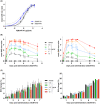Recombinant botulinum neurotoxin serotype A1 in vivo characterization
- PMID: 34632725
- PMCID: PMC8502944
- DOI: 10.1002/prp2.857
Recombinant botulinum neurotoxin serotype A1 in vivo characterization
Abstract
Clinically used botulinum neurotoxins (BoNTs) are natural products of Clostridium botulinum. A novel, recombinant BoNT type A1 (rBoNT/A1; IPN10260) has been synthesized using the native amino acid sequence expressed in Escherichia coli and has previously been characterized in vitro and ex vivo. Here, we aimed to characterize rBoNT/A1 in vivo and evaluate its effects on skeletal muscle. The properties of rBoNT/A1 following single, intramuscular administration were evaluated in the mouse and rat digit abduction score (DAS) assays and compared with those of natural BoNT/A1 (nBoNT/A1). rBoNT/A1-injected tibialis anterior was assessed in the in situ muscle force test in rats. rBoNT/A1-injected gastrocnemius lateralis (GL) muscle was assessed in the compound muscle action potential (CMAP) test in rats. The rBoNT/A1-injected GL muscle was evaluated for muscle weight, volume, myofiber composition and immunohistochemical detection of cleaved SNAP25 (c-SNAP25). Results showed that rBoNT/A1 and nBoNT/A1 were equipotent and had similar onset and duration of action in both mouse and rat DAS assays. rBoNT/A1 caused a dose-dependent inhibition of muscle force and a rapid long-lasting reduction in CMAP amplitude that lasted for at least 30 days. Dose-dependent reductions in GL weight and volume and increases in myofiber atrophy were accompanied by immunohistochemical detection of c-SNAP25. Overall, rBoNT/A1 and nBoNT/A1 exhibited similar properties following intramuscular administration. rBoNT/A1 inhibited motoneurons neurotransmitter release, which was robust, long-lasting, and accompanied by cleavage of SNAP25. rBoNT/A1 is a useful tool molecule for comparison with current natural and future modified recombinant neurotoxins products.
Keywords: SNAP25; botulinum; muscle; neurotoxin; recombinant; rodent.
© 2021 The Authors. Pharmacology Research & Perspectives published by British Pharmacological Society and American Society for Pharmacology and Experimental Therapeutics and John Wiley & Sons Ltd.
Conflict of interest statement
Cindy Périer, Vincent Martin, Sylvie Cornet, Christine Favre‐Guilmard, Marie‐Noelle Rocher, Alban Vignaud, Matthew Beard, Stephane Lezmi, and Mikhail Kalinichev are current or former employees of Ipsen. The research was funded by Ipsen.
Figures








References
-
- Aoki KR. Preclinical update on BOTOX® (Botulinum toxin type a)‐purified neurotoxin complex relative to other botulinum neurotoxin preparations. Eur J Neurol. 1999;6:S3‐S10. doi:10.1111/j.1468-1331.1999.tb00032.x - DOI
Publication types
MeSH terms
Substances
LinkOut - more resources
Full Text Sources
Medical

